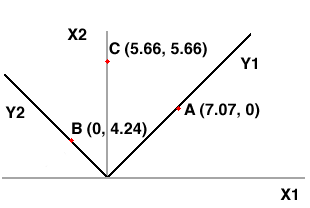 .
.It transforms X into Z, such that, mean(Z) = 0 and var(Z) = 1.
Linear Transformations: An Introduction
Consider a set of scores on variable X with mean(X) = 25 and var(X) = 10.
Further, we will create a new variable Y = 2X + 100, which has the form Y = aX + b, which is a linear transformation.
The mean of Y will equal 2*25 + 100 = 150 [mean(Y) = a*mean(X) + b]
The variance of Y will equal 4*10 = 40 [var(Y) = a2*var(X)]
Here is an example of a linear transformation that you should recognize:
 .
.
It transforms X into Z, such that, mean(Z) = 0 and var(Z) = 1.
Linear Transformations and Axis Rotations
Consider a bivariate normal distribution with an individual with the vector or point P, [x1, x2] = [8, 5] on axes X1 and X2 respectively
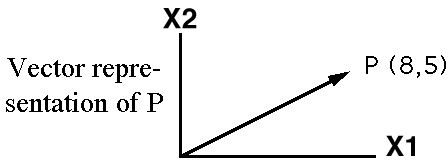
Consider the transformation given below:
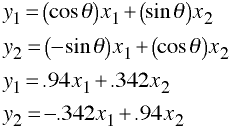
The point P now has the value [y1, y2] = [9.23, 1.964], which equivalent to a rigid rotation of the axes by 20°.
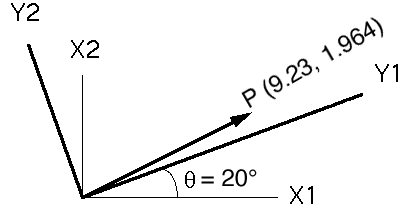
In effect we are defining a new set of variables which are a linear combination of the original variables y = ax1 + bx2.
Not all linear combinations are equivalent to axis rotation, only those in which a2 + b2 = 1. This can be checked by (cosθ)2 + (sinθ)2 = 1.
Further, given two linear combinations of x1 and x2,
y = ax1 + bx2 and z = cx1 + dx2
it must be the case that a*c + b*d = 0.
With these two constraints:
1) a2 + b2 =1
2) a*c + b*d = 0
the axes rotation is orthogonal. This constitutes a rigid rotation of the coordinate system.
Transformations
More generally the transformation can be written:

where x is the vector of original variables, y is the vector of transformed variables, and V is the transformation matrix. We say that vector x is transformed linearly into y by matrix V.
Rigid Rotation
In order for the transformation to represent a rigid rotation, it must be the case that,
V'V = I
From the earlier example,

It can be shown that V'V = I.
Pure Rigid Rotation
If Det(V) = |V| = 1 than we have a pure rigid rotation.
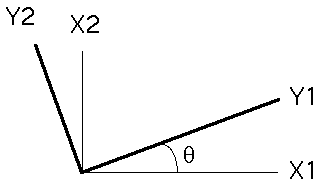 Figure: Pure rigid rotation thru angle θ.
Figure: Pure rigid rotation thru angle θ.
If Det(V) = |V| = -1 than we have a rigid rotation combined with reflection of one or more axes.
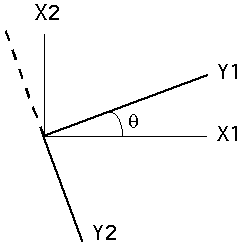 Figure: Pure rigid rotation and reflection of second axis.
Figure: Pure rigid rotation and reflection of second axis.
Orthonormal Matrix
When V'V = I and |V| = 1, V is said to be an orthonormal matrix (orthogonal and normal).
When V'V = I and |V| = -1, V is said to be an improper orthonormal matrix.
When either of these conditions are met the V' = V-1.
Transformations on SSCP Matrices
Given the SSCP for X, how does one find the SSCP for Y, the transformed variables. Remember

Thus

Or
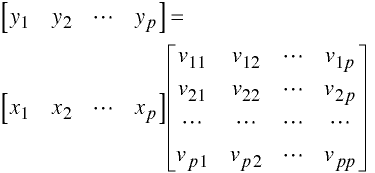

Which generalizes to
 in the matrix form.
in the matrix form.
SSCP
Let
 Substitute
Substitute
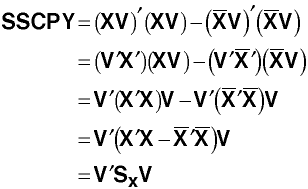
Consider the points A, B and C:
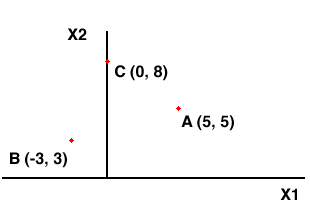
Axis Rotation
Let's rotate the axes -45 degrees. We can do this with the transformation
Y1 = cos(-45)X1 + sin(-45)X2
Y2 -sin(-45)X1 + cos(-45)X2
cos(45) = 0.707 and sin(45) = -0.707
Matrices
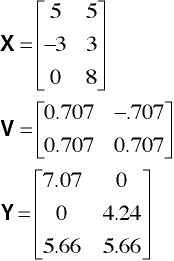
Matrix Multiplication
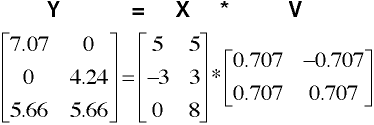
Plot of New Axes
